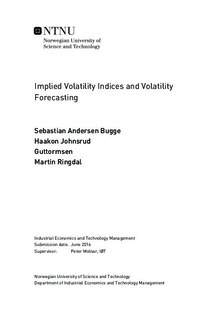Implied Volatility Indices and Volatility Forecasting
Master thesis
Permanent lenke
http://hdl.handle.net/11250/2433831Utgivelsesdato
2016Metadata
Vis full innførselSamlinger
Sammendrag
This thesis consists of two articles that study volatility forecasts and the value of implied volatility indices.
In the first paper, we construct implied volatility indices for all stocks in the Dow Jones Industrial Average Index, and study how they can improve volatility forecasts for the individual stocks. In addition, we utilize information about earnings announcement dates to account for these stock specific events. We find that both measures improve the volatility forecasts significantly. The implied volatility indices for individual stocks improve the forecasts more than the general VIX index. However, after we adjust for earnings announcements, we find that the VIX is equally useful as the individual implied volatility indices. On average, we are able to reduce the forecast errors by 9% compared to our benchmark model.
In the second paper, we construct and evaluate the NOVIX - an implied volatility index for the Norwegian market created according to the VIX methodology. Implied volatility indices have been an active area of research since the introduction of the VIX by CBOE in 1993. Since then, more and more exchanges have introduced their own implied volatility indices with great success, yet there exists no official index for the Norwegian market. We evaluate the relationship between the NOVIX and returns and realized volatility of the underlying OBX index, and find that the ability of the NOVIX to capture information has improved consistently over the last decade. For the most recent years, we find that the NOVIX has similar properties to the popular VIX and VDAX-NEW volatility indices from the U.S. and German markets.
